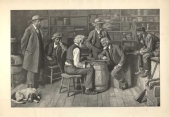The Checker Maven
The World's Most Widely Read Checkers and Draughts Publication
Bob Newell, Editor-in-Chief
Published every Saturday morning in Honolulu, Hawai`i
Noticing missing images? An explanation is here.
Another Heffner Gem

The term "gem" is often used to describe a particularly elegant checker problem; we've discussed this at various times and at various length in previous editions of The Checker Maven. What qualifies as a "gem" is highly subjective, and seems to fall into the "I'll know it when I see it" category. Now, there is no doubt the elegant piece of jewelry shown above is a "gem" in more than one sense of the word. Whether or not today's excerpt from Willie Ryan's Tricks Traps & Shots of the Checkerboard falls into the "gem" category is something you'll have to decide for yourself, after Willie sets the stage for us.

"Back in 1925, when I was learning checkers the hard way, I played the following game in a 30-game match with Mike Lieber, of Detroit, then one of the country's leading players:
| 10-14 | 27-24 | 11-16 | |
| 22-17 | 3- 7 | 24-20 | |
| 6-10 | 24-19 | 17-21 | |
| 17-13 | 11-16 | 20-11 | |
| 1-6 | 20-11 | 7-i6 | |
| 25-22 | 8-24 | 26-22 | |
| 14-17 | 28-19 | 16-20---A,1 | |
| 21-14 | 4-8 | 22-17 | |
| 9-25 | 22-18 | 20-24 | |
| 29-22 | 14-17 | 18-14 | |
| 10-14 | 32-27 | 2-7, | |
| 24-20 | 8-11 | reaching the | |
| 7-10 | 27-24 | diagrammed | |
| position." |
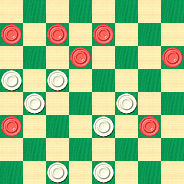
WHITE
White to Play and Win
W:W31,30,23,19,17,14,13:B24,21,12,10,7,6,5.
A---The losing move. 10-14 will insure a draw with a little care."
1---It seems somewhat unintuitive that going in for a king would lose, yet it indeed does. We ran a computer analysis, and it was interesting to see the computer start out by evaluating this as a weak move, but, as it ran deeper and deeper searches, downgrading the move to a highly probable loss. We can easily understand how a human player, even of Mr. Ryan's strength, could make this move---Ed.
We find Willie's comment, by the way, about "learning checkers the hard way" to be very revealing: if Willie learned "the hard way" then we suspect that all the rest of us learn the same way. Alas, there is no royal road to checker success--- but where would the fun be if there was?
In any event, see if you can find that sparkling, precious winning way, and then click on Read More to see all the facets of the solution.![]()
How to Win at Checkers

Today we're at long last presenting you with a newly-typeset electronic edition of one of the most complete books on the basics of the game ever published, Fred Reinfeld's How to Win at Checkers. We've previously written about Mr. Reinfeld and published a review of his book. Now, thanks to the generosity of Mr. Reinfeld's estate, who kindly authorized this edition, the book is available instantly, worldwide, and entirely free of charge. You can download it here.
Our further thanks and appreciation go out to anonymous checkerist "Mr. T." who scanned and edited the initial drafts of the new edition, reset the diagrams, and passed the results along to us.

To introduce you to the book, we've picked out a problem situation and present it below. (The book doesn't really have problems per se, just examples; but you can make your own problems by trying to solve the diagrams before looking at the text below them.) Here's a run-up to the diagram.
| BLACK | WHITE | |
| 1. | 10-15 | 22-18 |
| 2. | 15x22 | 25x1 |
| 3. | 6-10 | 29-25 |
| 4. | 10-15---A | 25-22---B |
A---An inferior move played to set a trap (usually bad strategy). 11-15 was correct.
B---Loses; White should have played 18-14 to keep the advantage
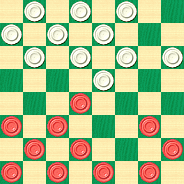
BLACK
Black to Play and Win
B:W32,31,30,28,27,26,24,23,22,21,18:B15,12,11,9,8,7,5,4,3,2,1.
We invite you to solve the problem, and then download the book to look up the solution (it is found under Diagram 33). We hope you enjoy and benefit from our new version of this classic work. ![]()
Through Thick and Thin

It seems that both our editorial and art departments were working at reduced intellectual capacity when they came up with the theme for this week's column, Through Thick and Thin, relying on an obscure and not all that clever multilingual pun.
Though we'd rather not embarrass ourselves with the explanation, here goes: today's position is attributed to late 19th century checkerist George Dick. Now, in the German language, "dick" means "fat" or alternatively--- you guessed it---- "thick." It gets worse from here: the position below, having only a few pieces and those arrayed on just a few ranks of the checkerboard, is rather "thin" in looks. Thus we have "thick" and "thin" although frankly, we'd rather we didn't.
The job market in Hawaii isn't that great, so we won't fire all the staff and start over. Instead, we'll just "carry on" as usual, as there is some great checker content in today's problem, solution, sample game, and notes; there is even a short historical anecdote which contains a supplemental problem.
BLACK
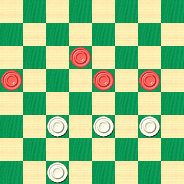
WHITE
White to Play and Win
W:W30,24,23,22:B16,15,13,10.
The obvious question is this: what's here that can give White a win? White can win a man but Black will just get it back a couple of moves later. Yet the win is there, even if by just a "thin" margin. Can you find it, or is the problem a bit too dense (i.e., "thick") to solve?
You're surely a hardy checkerist, looking for the win through thick and thin, so go and find the answer, then click on Read More to settle the score.
My goodness, have we ever outdone ourselves this week.![]()
Heffner's Hurricane

There's nothing like a hurricane to show the incredible power of nature, and if you've ever experienced one in person, you'll know exactly what we mean. The howling wind, the lashing rain, and if you're near the ocean, the roaring surf, combine in an incredible and fearsome cacaphony. In fact, this might be something better not experienced in person.
Hurricanes can take place on the checkerboard as well, and while they're destructive and fearsome in their own way, thankfully the only thing damaged is perhaps a player's ego, and even that not for long. Willie Ryan, in his fine book Tricks Traps & Shots of the Checkerboard, tells us today about a storm originated in the play of checkerist A. J. Heffner, and quite a tempest it is. Here's Willie to tells us more.

| 9-14 | 3-7 | 11-16 |
| 24-20 | 24-19 | 18-15 |
| 10-15 | 11-16 | 14-18 |
| 22-18 | 20-11 | 15-6 |
| 15-22 | 8-24 | 18-25 |
| 25-9 | 28-19 | 26-22 |
| 5-14 | 4-8 | 25-29 |
| 29-25 | 22-18 | 21-17 |
| 7-10 | 8-11 | 9-13 |
| 25-22 | 26-22 | 19-15---B |
| 6-9 | 1-5 | 2-9 |
| 27-24 | 31-26---A | 32-27---1 |
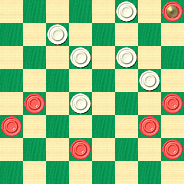
BLACK
Black to Play and Win
B:W30,27,23,22,17,15:BK29,16,13,12,9,7,5.
A---"If 32-28 is played, then a draw is established with: 11-15, 18-11, 7-16, 22-17, 9-13, 28-24, 13-22, 24-20, 14-18, 23-27, 2-11, 19-15, 11-18, 20-11, 18-23, 11-7, 12-16, 7-2, 16-20, 2-6, 23-27, 31-24, 20-27, 6-10, 5-9.
B---Appears to win, but loses. The correct play is: 6-1, 7-10, 32-28, 5-9, 1-6, 9-14, 6-15, 14-21, 22-18, 29-25, 18-14, 25-22, 14-10; at this point 13-17* is drawable, but 22-26 allows the hidden win by white with: 28-24*!, 16-20, 30-25*!, 21-30, 23-18, 20-27, 19-16, 12-19, 15-22. I missed this pulverizer against Tom Wiswell in the 1940 New York State Championship Tourney."
1---23-18 appears to be better here, but still loses. As the proverbial exercise for the reader, you might wish to work out this alternative line of play, perhaps with the help of your computer---Ed.
Don't be blown away by this one; find your way through the storm and reach the solution. When you're finished, click on Read More to clear the air.![]()
Blind Man's Bluff

Most of us take our sight for granted, and we often forget that there are those among us who don't have this gift. Now, note that we don't call them "unfortunates"; we'd rather call them "inspirations" because the blind among us are capable of incredible things, often with a drive and willpower that puts the rest of us to shame.
An old time checker-player, one Mr. W. Bennett, was blind, but that didn't slow him down in the least, as the instructive problem below illustrates well.
BLACK
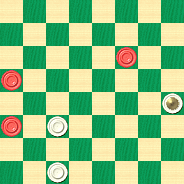
WHITE
White to Play and Win
W:WK20,22,30:B11,13,21.
Can you solve it? For an extra challenge, try to work it out the way Mr. Bennett did; solve the problem not only without moving the pieces, but without looking at the diagram or a checkerboard. Along the way, you'll discover a subtle and practical winning technique which you'll be able to put to use in your own play.
When you've completed this truly illuminating exercise, click on Read More for the solution, a sample game, and notes.![]()
[Read More]
Lee's Loophole

Does our photo show a 'loophole,' as advertised in our column's title, or something much more nefarious? That's the subject of today's excerpt from Willie Ryan's book, Tricks Traps & Shots of the Checkerboard. Willie sees a loophole. What do you see?
First, though, let's have Willie give us a brief introduction.

"Of the many subtle stratagems to be found in the mellowed pages of checker lore, none has impressed me so much as the deeply rooted Paul J. Lee 'rebound,' which I consider the best concealed drawing device I have ever seen. It may be brought up in play from various openings. Here is one method:"
| 10-15 | 24-19 | 6-9 |
| 22-18 | 15-24 | 22-18 |
| 15-22 | 28-19 | 1-6 |
| 25-18 | 8-11 | 21-17---1 |
| 9-13 | 29-25 | 13-22 |
| 18-14 | 11-16 | 26-17 |
| 11-15 | 25-22 | 6-10 |

WHITE
White to Play and Draw
W:W32,31,30,27,23,19,18,17,14:B16,12,10,9,7,5,4,3,2.
What will it be? Loophole or constriction? Can you solve this one without choking up? When you've made your attempt, slip your mouse through to Read More to see the outcome.![]()
1---26-22 would have made for an easier journey for White---Ed.
[Read More]Up The Creek Without A Paddle

The guy in the photo above has got a real problem: he's literally up the creek without a paddle. We really don't know how he's going to get back to shore. Maybe he can paddle with his hands, or swim if it isn't too far. Otherwise, he'd better have a cell phone and hope--- very hard--- that it works.
In today's Checker School lesson, life and limb may not be at risk, but the outcome of the game certainly is. In the first diagram below, attributed to our old checker friend from last month, A. Sheehan, White seems to be in the same predicament as our hapless hero above. In the second diagram, credited to Charles Hefter, things look a little better but White is still not out of the water, so to speak.
BLACK

WHITE
White to Play and Draw
W:WK8,K18,31:BK9,28,K30,K32.
BLACK

WHITE
White to Play and Draw
W:WK12,24:BK10,K32.
The solution to the first problem is anything but easy, so we'll give you a hint: solve the second problem first, then see if you can work out play from the first diagram to end up at the position of the second. And if you're still up the creek, paddle your mouse to Read More to see the solutions, detailed notes, sample games, and a bonus feature.![]()
Buchanan's Block
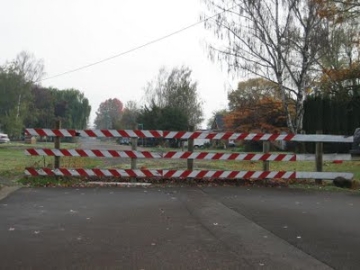
Sometimes, progress is simply blocked. For example, in our photo above, we're not going to be able to travel any further along this road, given the rather substantial looking roadblock that's right in front of us. But at least we have the option of turning around and trying another route.
In the game of checkers, a "block" means something similar. Our pieces might be blocked from going in a certain direction, and we have to seek another (though unless they're kings they can't turn around and go back). But if all of our pieces are blocked in all directions, we have a problem for sure: we've lost the game!
In his famous Tricks Traps & Shots of the Checkerboard, author Willie Ryan serves up various examples of blocks for our entertainment and tuition. Here's an over-the-board example that we'll let Willie tell us about it personally.

"Former American Champion Edwin F. Hunt, of Nashville, Tennessee, once defined Checkers as a "battle of ideas." The more ideas or strategic devices the learner can create or anticipate as he plays a game, the more skillful and versatile he becomes. Here is an artistic game I played several years ago with Basil Case, in which I managed to save what appeared to be a hopeless position by utilizing a block or smother idea.
| 9-14 | 18-15 | 6-10 |
| 22-18 | 7-11 | 24-20 |
| 5- 9 | 29-25 | 16-19 |
| 24-19 | 11-18 | 20-16 |
| 11-15 | 23-14 | 19-24 |
| 18-11 | 8-11 | 16-12 |
| 8-24 | 25-22 | 10-15 |
| 28-19 | 11-16 | 11-8 |
| 4- 8 | 14-10---2 | 2-7 |
| 25-22 | 6-24 | 8-4 |
| 9-13---1 | 27-11 | 24-28 |
| 22-18 | 12-16 | 4- 8 |
| 14-17 | 31-27 | 7-11 |
| 21-14 | 1-6 | 8- 4---A |
| 10-17 | 27-24 |
This brought about the diagrammed position.
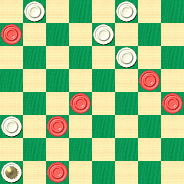
BLACK
Black to Play and Draw
B:W32,30,26,22,12,K4:B28,17,15,13,11,3.
A---Forms a position with which the great George Buchanan of Scotland gained a draw against Thomas Ballantyne in the 1897 Scottish Championship Tourney."
1---Definitely not best; 8-11 would be good here---Ed.
2---Gives up the edge; 27-23 would have held on to a definite White advantage---Ed.
Can you find your way out of the situation and achieve a Black draw, or will you encounter a mental block? We hope not, but we won't try to block your mouse from clicking on Read More to reveal the solution.![]()
Saving the Bacon

In this month's lesson in our Checker School series, we look at two positions in which White is about to fry Black's bacon ... yet Black is expected to save it. In both instances, Black is a man down and the fat is in the fire. Let's have a look at the diagrams below, attributed respectively to A. Sheean and F. O'Melay, and the famous Dr. T. J. Brown.
WHITE

BLACK
Black to Play and Draw
B:W32,30,21,K18,11:BK25,23,22,13,3.
WHITE
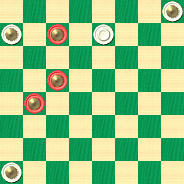
BLACK
Black to Play and Draw
B:WK29,K28,26,K4:BK27,K19,K16.
Can you save the bacon in these two cases? We must warn you the first problem is at the higher end of the difficulty spectrum, and while the second is a bit easier, it's all relative. In any case, grease your thinking cap and don't get fried; you can always click on Read More for the tasty solutions, which are served up with detailed notes and a sample game.![]()
Searight's Escape

Houdini was arguably the greatest (or at least the most famous) escape artist of all time. Some of his daring feats, like the water-tank escape shown above, are definitely not recommended for trial at home; not, at least, if you value your life.
Checkerist Searight most probably never did a water-tank exhibition, but his checkerboard feats are as classy in the checker world as Houdini's were his own realm. Today, we quote Willie Ryan in Trips Traps & Shots of the Checkerboard, as he describes one of Mr. Searight's more amazing checkerboard escapes.

"You'll never be a champion at checkers unless you thoroughly familiarize yourself with all the better-known losses that have been the undoing of great players in the past. By studying the mistakes of the masters, you can avoid the costly errors they made, and gain knowledge that would take years to acquire by practical experience. Among the 'must' positions is Searight's draw. The game mapped out below was contested by Champion Newell W. Banks and me. When Banks reached the diagrammed stage, he 'muffed' a draw, losing the game and the match."
| 11-16 | 9-18 | 7-10 |
| 22-17 | 23-14 | 22-18 |
| 16-20 | 1-6 | 3-7 |
| 17-14 | 24-19 | 13-9 |
| 10-17 | 15-24 | 5-14 |
| 21-14 | 28-19 | 18- 9 |
| 9-18 | 6-10 | 11-15 |
| 23-14 | 30-26 | 32-28 |
| 8-11 | 10-17 | 15-24 |
| 25-22 | 22-13 | 28-19 |
| 11-15 | 4-8 | 7-11 |
| 29-25 | 25-22 | 27-24 |
| 6- 9 | 8-11 | 20-27 |
| 26-23 | 26-23 | 31-24---1 |
1---Impeccable play up to this point---Ed.
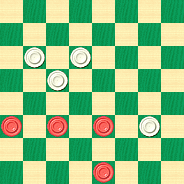
BLACK
Black to Play and Draw
B:W9,19,23,24:B2,10,11,12.
Can you escape with your life in this position, or will you pay the price of failure? We won't say there's an easy out; some struggling is necessary, but it's worth it. Get on with the show, and then slip out to Read More to see the solution and notes.![]()
The Checker Maven is produced at editorial offices in Honolulu, Hawai`i, as a completely non-commercial public service from which no profit is obtained or sought. Original material is Copyright © 2004-2025 Avi Gobbler Publishing. Other material is public domain, as attributed, or licensed under Creative Commons. Information presented on this site is offered as-is, at no cost, and bears no express or implied warranty as to accuracy or usability. You agree that you use such information entirely at your own risk. No liabilities of any kind under any legal theory whatsoever are accepted. The Checker Maven is dedicated to the memory of Mr. Bob Newell, Sr.

